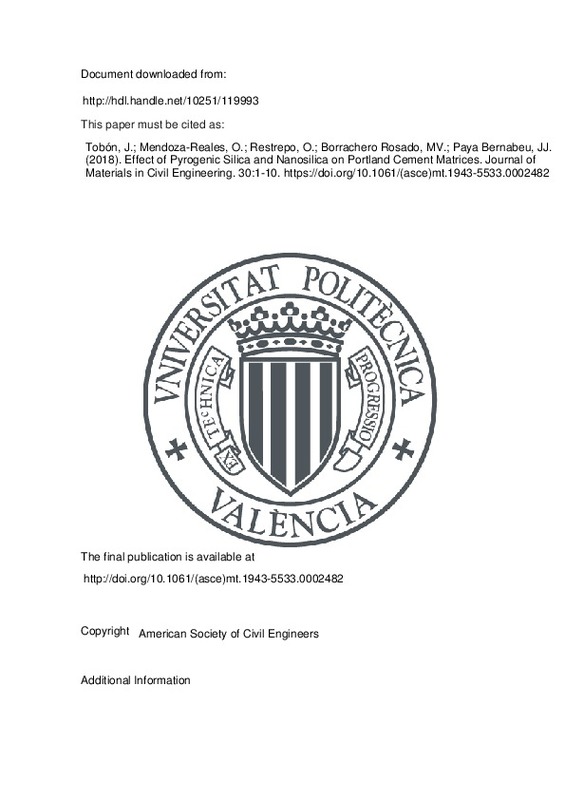JavaScript is disabled for your browser. Some features of this site may not work without it.
Buscar en RiuNet
Listar
Mi cuenta
Estadísticas
Ayuda RiuNet
Admin. UPV
Effect of Pyrogenic Silica and Nanosilica on Portland Cement Matrices
Mostrar el registro sencillo del ítem
Ficheros en el ítem
| dc.contributor.author | Tobón, J.I.
|
es_ES |
| dc.contributor.author | Mendoza-Reales, O.
|
es_ES |
| dc.contributor.author | Restrepo, O.J.
|
es_ES |
| dc.contributor.author | Borrachero Rosado, María Victoria
|
es_ES |
| dc.contributor.author | Paya Bernabeu, Jorge Juan
|
es_ES |
| dc.date.accessioned | 2019-05-06T20:01:50Z | |
| dc.date.available | 2019-05-06T20:01:50Z | |
| dc.date.issued | 2018 | es_ES |
| dc.identifier.issn | 0899-1561 | es_ES |
| dc.identifier.uri | http://hdl.handle.net/10251/119993 | |
| dc.description.abstract | [EN] In this work, the effect of pyrogenic silica and nanosilica on the properties of portland cement matrices is compared. Two chemically and mineralogically similar mineral additions (amorphous silica) with different particle size and specific surface area were used to prepare pastes and mortars with different solids substitutions of cement by silica. These samples were used to measure water and superplasticizer demand, setting time, hydration kinetics, water absorption by capillary suction, and compressive strength. It was found that specific surface area, rather than particle size, played a crucial role in the amount of water and superplasticizer necessary to obtain a desired workability in pastes and mortars. Such water and superplasticizer demands had a delaying effect on the setting time and hydration kinetics of pastes. Nevertheless, compressive strength results at different curing ages of mortars were found to have a direct correlation with the porous structure of the matrix, rather than with the specific surface area of the silica particles. It was concluded that regardless of its higher specific surface area and greater effect on the fresh state properties of pastes, pyrogenic silica was less efficient than nanosilica to increase the compressive strength of mortars, being considered a less efficient pozzolanic material. | es_ES |
| dc.language | Inglés | es_ES |
| dc.publisher | American Society of Civil Engineers | es_ES |
| dc.relation.ispartof | Journal of Materials in Civil Engineering | es_ES |
| dc.rights | Reserva de todos los derechos | es_ES |
| dc.subject | Nanosilica | es_ES |
| dc.subject | Pyrogenic silica | es_ES |
| dc.subject | Hydration of cement | es_ES |
| dc.subject | Setting time | es_ES |
| dc.subject | Specific surface area of mineral addition | es_ES |
| dc.subject.classification | INGENIERIA DE LA CONSTRUCCION | es_ES |
| dc.title | Effect of Pyrogenic Silica and Nanosilica on Portland Cement Matrices | es_ES |
| dc.type | Artículo | es_ES |
| dc.identifier.doi | 10.1061/(asce)mt.1943-5533.0002482 | es_ES |
| dc.rights.accessRights | Abierto | es_ES |
| dc.contributor.affiliation | Universitat Politècnica de València. Departamento de Ingeniería de la Construcción y de Proyectos de Ingeniería Civil - Departament d'Enginyeria de la Construcció i de Projectes d'Enginyeria Civil | es_ES |
| dc.description.bibliographicCitation | Tobón, J.; Mendoza-Reales, O.; Restrepo, O.; Borrachero Rosado, MV.; Paya Bernabeu, JJ. (2018). Effect of Pyrogenic Silica and Nanosilica on Portland Cement Matrices. Journal of Materials in Civil Engineering. 30:1-10. https://doi.org/10.1061/(asce)mt.1943-5533.0002482 | es_ES |
| dc.description.accrualMethod | S | es_ES |
| dc.relation.publisherversion | http://doi.org/10.1061/(asce)mt.1943-5533.0002482 | es_ES |
| dc.description.upvformatpinicio | 1 | es_ES |
| dc.description.upvformatpfin | 10 | es_ES |
| dc.type.version | info:eu-repo/semantics/publishedVersion | es_ES |
| dc.description.volume | 30 | es_ES |
| dc.relation.pasarela | S\374507 | es_ES |







![[Cerrado]](/themes/UPV/images/candado.png)

